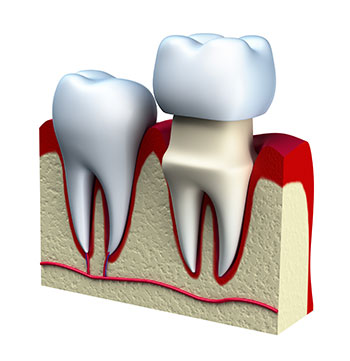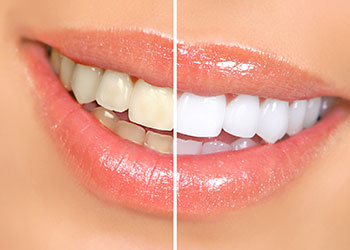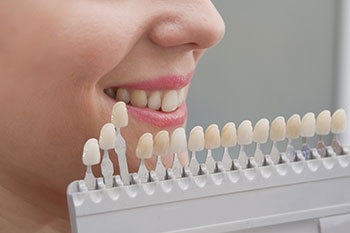Your smile is one of the first things that people notice about you, but if it has cosmetic issues, you may not feel like you’re making the best impression that you can be. Cosmetic dentistry can come to the rescue. This specialized type of dental care focuses on improving the aesthetics of your smile and can address a variety of issues, ranging from discolored teeth to those that are damaged or undersized.
Learn more about the many possibilities for enhancing your smile through cosmetic dentistry. Schedule an initial evaluation at our office to explore your options.
Achieving A Beautiful Smile Through Cosmetic Dentistry
Patients who seek cosmetic dentistry treatments may be dissatisfied with their smiles for any number of reasons. They may dislike the color of their teeth or be self-conscious about staining due to habits like drinking wine or coffee or smoking. They may have damaged teeth that detract from their smiles, or other issues such as disproportionately small teeth or slightly crooked teeth. Cosmetic dentistry can resolve any or all of these issues.
Common Cosmetic Dentistry Interventions
A cosmetic dentistry treatment plan may include any of the following interventions:
Composite Fillings
When bacteria in your mouth is exposed to sugars, they metabolize these sugars to produce acids. These acids weaken the tooth and may eventually lead to a cavity.
A cavity is often treated with a filling. Many materials have been used to fill teeth with composite fillings being the most popular because of their cosmetic, tooth-colored appearance and increasing strength. Composite fillings are ideal for smaller cavities as they require less tooth removal then amalgam fillings. They are indicated in fillings on front teeth due to their natural tooth-colored appearance and ease of matching the shade and color of existing teeth.
When placing a composite filling, any decayed portions of the tooth must be removed. The tooth is then lightly conditioned with an acid. To help form a layer for the composite to “bond” to, a composite bonding adhesive is placed into the area where the cavity was removed. The composite is then layered and molded on to the adhesive. A light is then used to harden the composite. Once hardened, the composite is then adjusted to your bite, smoothed and polished.
This is far from a comprehensive list of cosmetic dentistry treatments, so please ask our staff about other options if none of these address your particular issue.
Crowns
If a cavity is left untreated, it may become large enough to compromise the strength of the tooth or cause the tooth to break. In these cases, a filling may not be sufficient and a crown may be needed to strengthen the tooth. A crown is a dental restoration which completely encircles or “caps” the tooth decreasing the risk of future fracture while also improving the appearance of the tooth.
Crowns may be fabricated from a number of materials including metals such as gold, platinum, and palladium, various types of porcelain ceramics, or a combination of these materials. The material chosen for a crown is determined by a patients cosmetic needs as well as the biting/chewing forces expected to be applied on the tooth being restored.
A crown normally requires two dental visits. During the first appointment, the decayed/broken tooth will be prepared for the crown. An impression is usually taken of the prepared tooth with a putty. The impression will be used by a dental lab to fabricate the crown. A temporary crown is placed on the prepared tooth to protect the tooth until the permanent crown can be cemented. During the second appointment, the lab fabricated crown is fit to the tooth. The crown is checked for fit, shape, and color. It is then cemented with either an adhesive or luting cement.
Bridges
When a tooth is lost, a bridge is one option to replace the lost tooth. When teeth are lost form, function and esthetics may be compromised. Missing or lost teeth may lead to shifting of adjacent teeth which may eventually affect the health of those teeth. Missing or lost teeth may make it difficult to bite, tear and chew your food. The loss of a front tooth can greatly impact the way you look. Replacing a missing tooth with a dental bridge can help restore a more youthful appearance as they support your cheek and lips preventing the “sunken in” look which becomes evident as people age.
A dental bridge helps replace lost teeth by attaching a false tooth to adjacent natural teeth. A bridge consists of the abutment and the pontic. The Abutments are the natural teeth adjacent to the missing teeth which support the bridge. The pontics are the false teeth that are attached to the abutments. The Abutments function to support the pontics of the Bridge.
After the tooth is lost, the adjacent natural teeth are first prepared. An impression of your teeth is taken. A Dental Bridge is fabricated by a dental lab from the impression to precisely fit your teeth. After the Bridge has been fabricated, it is either bonded or cemented to the abutment teeth while replacing missing teeth with pontic teeth.
It is important to replace missing teeth to maintain normal function, oral health, and a natural, youthful appearance. Dental Bridges help maintain your overall oral health by preventing movement of adjacent teeth. Dental Bridges restore your ability to bite, tear and chew food. Dental Bridges restore your appearance as they fill in spaces due to lost teeth and help support your lip and cheeks.
Teeth Whitening
Who needs whitening?
 Over time, teeth may discolor and stain. Years of smoking cigarettes, certain medications, many foods as well as coffee, tea, wine, and soft drinks can discolor your once bright gleaming smile. Dental whitening or bleaching is a cosmetic procedure which can remove those dingy stains and help restore your pearly white smile almost instantaneously without damaging your natural teeth. Teeth whitening is a quick, painless, cost-effective option for anyone who is looking to enhance their natural smile.
Over time, teeth may discolor and stain. Years of smoking cigarettes, certain medications, many foods as well as coffee, tea, wine, and soft drinks can discolor your once bright gleaming smile. Dental whitening or bleaching is a cosmetic procedure which can remove those dingy stains and help restore your pearly white smile almost instantaneously without damaging your natural teeth. Teeth whitening is a quick, painless, cost-effective option for anyone who is looking to enhance their natural smile.
How are teeth whitened?
There are multiple options to whiten your teeth. Many kinds of toothpaste contain a whitening component. Regular use of these kinds of toothpaste may produce a slight improvement in the brightness of your teeth which may be adequate in mild cases of discoloration. However, it is unlikely whitening toothpaste will produce the desired results with moderate to severely discolored teeth.
Over-the-counter whitening kits have also become readily available to help restore your smile. Most of these kits contain strips with a mild bleaching agent which will remove some surface stains, but they may not remove deeper stains or may not be able to reach stains that appear in between teeth.
Take home whitening kits dispensed by Dr. Kapadia to contain a bleaching agent that may provide the desired results in most cases. Take home kits provided by Dr. Kapadia to include trays custom fit to your teeth as well as a more concentrated bleaching agent than available over-the-counter. The bleaching agent is placed into the trays which are worn for an hour a day for 7-10 days. The more concentrated bleaching agent can safely penetrate tooth enamel to remove deeper stains while the custom fit trays allow the bleaching agent to remove stains from hard to reach surfaces of your teeth.
In cases where waiting 1-2 weeks may be too long to obtain the attractive smile you desire, in-office teeth whitening is available. In-office whitening can give you the pearly white smile you desire within an hour. In-office whitening techniques utilize a more concentrated bleaching agent that is applied to the teeth for 15 minutes and rinsed. This process may be repeated 3-4 times and you see results immediately! Results may vary based on the type and depth of staining, but it is normal to see your teeth 2-4 shades lighter!
Dental Veneers
 These tooth-shaped shells are like the Swiss army knives of dentistry! They can be used to correct any number of cosmetic defects, and because they are made of porcelain, they have a lifelike aesthetic.
These tooth-shaped shells are like the Swiss army knives of dentistry! They can be used to correct any number of cosmetic defects, and because they are made of porcelain, they have a lifelike aesthetic.
How is a veneer prepared?
Veneers usually require two appointments for placement. Usually, the teeth receiving veneers will need to be minimally prepared. A minimal amount of tooth structure must first be removed so that when the veneers are placed, it does not appear too bulky. Local anesthesia may be needed for this step. After the teeth are prepared, an impression will be taken which will be used by our dental lab to fabricate the veneers. Before the veneers are made, you will have a chance to decide on the size, shape, and shade of your veneers. The impression, as well as your preferences, are sent to the lab for fabrication of the veneers. Once the veneers have been fabricated, the veneers are bonded on with adhesives and resin cement.
With proper care and maintenance, veneers can last for many years. To prevent damaging your veneers, a night guard is recommended.
Dental Bonding
Dental bonding is a cosmetic procedure that is to treat small spaces between teeth, chipped or cracked teeth or discolored teeth. Dental bonding is used as an alternative to veneers to correct cosmetic concerns with your front teeth.
Dental bonding generally requires little to no removal of tooth structure. The tooth is first conditioned and then an adhesive is applied and allowed to set. Dr. Kapadia then sculpts a tooth-colored filling material to correct the cosmetic defect. The filling material is set with a high-intensity light and then the bonding is shaped and polished.
The dental bonding procedure can be used to correct a cosmetic defect on a front tooth in a single visit. However, because the filling material is not as strong as your natural tooth, fracture of the dental bonding may occur and may need replacement every few years.
A Customized Cosmetic Dentistry Treatment Plan Delivers Optimal Outcomes
At your initial consultation, your dentist will thoroughly examine your smile. This process may involve taking photographs, x-rays or dental impressions, depending on which treatment or treatments you’re pursuing. All of this information is used to develop a customized treatment plan for your particular case.
Although each patient is different, your dentist may be able to show you photos from previous patients with similar issues. This can give you a better idea of what to expect from your cosmetic dentistry treatments, although you should keep in mind that results do vary from case to case.



 Over time, teeth may discolor and stain. Years of smoking cigarettes, certain medications, many foods as well as coffee, tea, wine, and soft drinks can discolor your once bright gleaming smile. Dental whitening or bleaching is a cosmetic procedure which can remove those dingy stains and help restore your pearly white smile almost instantaneously without damaging your natural teeth. Teeth whitening is a quick, painless, cost-effective option for anyone who is looking to enhance their natural smile.
Over time, teeth may discolor and stain. Years of smoking cigarettes, certain medications, many foods as well as coffee, tea, wine, and soft drinks can discolor your once bright gleaming smile. Dental whitening or bleaching is a cosmetic procedure which can remove those dingy stains and help restore your pearly white smile almost instantaneously without damaging your natural teeth. Teeth whitening is a quick, painless, cost-effective option for anyone who is looking to enhance their natural smile. These tooth-shaped shells are like the Swiss army knives of dentistry! They can be used to correct any number of cosmetic defects, and because they are made of porcelain, they have a lifelike aesthetic.
These tooth-shaped shells are like the Swiss army knives of dentistry! They can be used to correct any number of cosmetic defects, and because they are made of porcelain, they have a lifelike aesthetic.